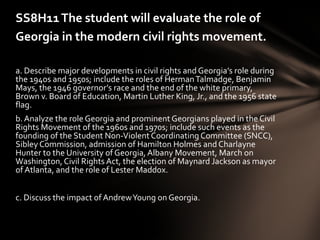
Standard 11 notes
- 1. SS8H11 The student will evaluate the role of Georgia in the modern civil rights movement. a. Describe major developments in civil rights and Georgia’s role during the 1940s and 1950s; include the roles of Herman Talmadge, Benjamin Mays, the 1946 governor’s race and the end of the white primary, Brown v. Board of Education, Martin Luther King, Jr., and the 1956 state flag. b. Analyze the role Georgia and prominent Georgians played in the Civil Rights Movement of the 1960s and 1970s; include such events as the founding of the Student Non-Violent Coordinating Committee (SNCC), Sibley Commission, admission of Hamilton Holmes and Charlayne Hunter to the University of Georgia, Albany Movement, March on Washington, Civil Rights Act, the election of Maynard Jackson as mayor of Atlanta, and the role of Lester Maddox. c. Discuss the impact of Andrew Young on Georgia.
- 2. Herman Talmadge Re-elected governor in 1950 Expanded schools to include grades 1-12 Lengthened school year to 9 months Raised standards for buildings, equipment, transportation and school curricula 3 percent tax passed to pay for changes
- 3. Benjamin Mays Educator and president of Morehouse College Mentor to MLK, Jr. Chairman of the Atlanta Board of Education Has a street and a high school named in his honor in southwest Atlanta
- 4. 1946 Governor’s Race (The Three Governors Episode) Eugene Talmadge was elected but died before taking office Three men claimed the office: Ellis Arnall (current governor), Herman Talmadge (Eugene’s son who was chosen by the legislature based on write-in votes in the election) and Melvin Thompson (Lt. Governor) In March, the Georgia Supreme court ruled that Melvin Thompson was the rightful head of the state until a special election could be held in 1948 Herman Talmadge won that election
- 5. 1956 State Flag Many were offended by the Confederate battle emblem on the flag because of its references to slavery Others felt it was a memorial to the war dead The flag was hurting business and tourism in the state Gov. Roy Barnes changed the flag Sonny Perdue promised to change the flag if elected
- 6. End of the White Primary The state allowed only white Democrats to vote in the primary elections (those in which candidates from each party are chosen) This kept blacks from choosing their own candidates – they were only allowed to vote in the general election in which there really wasn’t a choice In 1946, the U. S. Supreme Court, Georgia’s white primary system unconstitution (King V. Chapman)
- 7. The Supreme Court and Education 1948: racial integration ordered in armed forces 1950: Brown v. Board of Education – case struck down “separate but equal” concept; schools were to be integrated Sibley Commission: found that most Georgians would rather close schools than integrate More private schools opened 1961: Charlayne Hunter and Hamilton Holmes first African American students at UGA 1971: All Georgia public schools integrated
- 8. Montgomery Bus Boycott Dec. 1, 1955: Rosa Parks, African American, refused to give up her bus seat to whites in Montgomery, AL Dr. Martin Luther King, Jr. and the NAACP organized civic leaders and prepared marches Supreme court ruled segregation on public transportation unconstitutional
- 9. A Nonviolent Movement is Born Martin Luther King, Jr. of Atlanta Developed a nonviolent approach to social change Four-prong approach: • direct, nonviolent actions • legal remedies • ballots • economic boycotts SCLC: Southern Christian Leadership Conference – civil rights group led by Dr. King Sit-in: Dr. King’s strategy to people refuse to leave a public building until their demands are met
- 10. The Albany Movement 1961: Albany, GA becomes center of civil rights activity SNCC: Student Nonviolent Coordinating Committee – challenged segregated bus system in Albany Nearly 500 people jailed Biracial committee formed to study concerns of African Americans
- 11. Protests Move to Alabama 1963: Martin Luther King, Jr. begins work to integrate all aspects of public life in Birmingham, AL Over 3000 people arrested Bomb killed 4 black children in their church African Americans and whites from the north and south began to join together to stop the violence
- 12. The Civil Rights Act President Kennedy created new civil rights laws Kennedy was assassinated before the new laws came into effect Lyndon Johnson became president and pushed for passage of the Civil Rights Act of 1964 All public facilities had to be integrated Discrimination was prohibited in business and labor unions
- 13. The Voting Rights Act 1964: Freedom Summer – Martin Luther King, Jr. and SNCC worked to get African Americans registered to vote Selma-to-Montgomery, AL march led by Dr. King Nearly 30,000 marchers Congress passed the Voting Rights Act of 1965 – one million African Americans were registered to vote
- 14. A Shift in Mood Some people moved from the nonviolent strategies to more aggressive ones SNCC and “Black Panthers” confronted police Malcolm X preached black separatism Race riots in Los Angeles, Detroit, and Newark April 1968: Dr. King assassinated in Memphis, TN while working with striking sanitation workers
- 15. Atlanta: A Case Study in Change Integration in Atlanta was relatively peaceful Church leaders get much credit for this peaceful change William Hartsfield: Atlanta mayor who expanded Atlanta’s airport and worked with African American and white leaders; worked to integrate Atlanta’s schools Ivan Allen: Atlanta mayor ordered removal of “white” and “colored” segregation signs in the City Hall; integrated police and fire services and city government Troubled times followed but were overcome The city became known as “the city too busy to hate” Click to return to Table of Contents.
- 16. Lester Maddox Elected governor 1967 Segregationist who surprised everyone by appointing more blacks to state boards and commissions than all prior governors combined